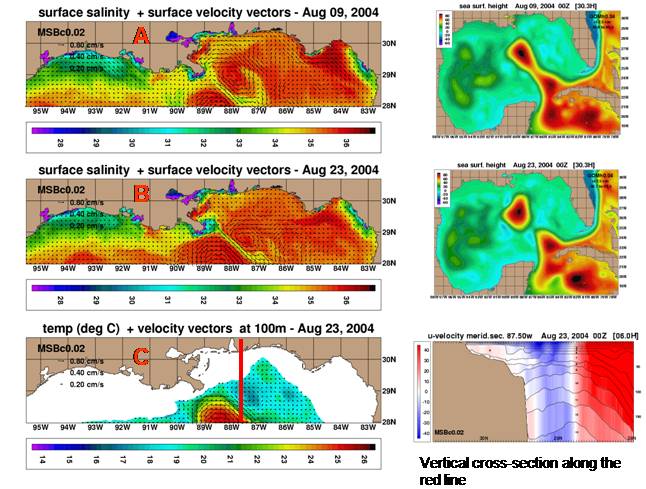DESCRIPTION:
(Upper and Middle): Snapshots of Sea Surface Salinity and surface velocity vectors in August 2004, showing an event of offshore removal of plume waters by the Loop Current (A) and after the shedding of a Loop Current Eddy (B). Associated Sea Surface Height fields from the GOM-HYCOM domain are presented on the right panel.
(Lower): Snapshot of temperature and velocity vectors at 100m depth, illustrating the intrusion of the Loop Current Eddy in the NGOM-HYCOM domain. The zonal velocity field and the displacement of the isopycnal layers caused by the eddy are shown on the right panel (vertical section along 87.5 ºW, represented by the red line).
The realistic simulation results demonstrate events of strong interaction between the Mississippi River plume and offshore circulation processes. For instance, during an event of Loop Current in close proximity to the Mississippi River Delta (August 2004), strong offshore removal of plume waters was enacted for approximately 15 days. This process was facilitated by weak winds during that period and by the steep shelf break in the vicinity of the delta (DeSoto Canyon). The dipole circulation generated by the edge of the Loop Current and a cyclonic eddy (Panel A) generated strong offshore currents that effectively entrained plume waters. Later in the month, these plume waters were transported directly offshore along the edge of the Loop Current Eddy (Panel B). At the same time, this Loop Current Eddy transported warm waters to the NGOM region and promoted strong temperature gradients at depth (Panel C).
CONTACT:
Villy Kourafalou — vkourafalou@rsmas.miami.edu
Rafael Schiller — rschiller@rsmas.miami.edu




